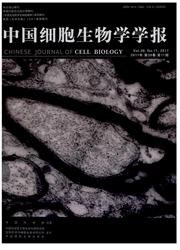

 中文摘要:
中文摘要:
探讨树突状细胞(DC)在肾纤维化大鼠肾小管间质中分布,以及缬沙坦对DC浸润聚集的干预作用。建立肾大部切除大鼠模型,随机分为正常组(n=18),假手术组(n=18),模型组(n=18),缬沙坦治疗组(n=18)。分别于建模1、4、12周取肾组织,采用HE和Masson染色评定各组肾小管问质纤维化(TIF)程度;采用免疫双染及荧光图像分析法,观察DC-SIGN+DC在各组大鼠肾组织中分布变化;采用免疫组化方法,观察P-选择素以及TGF-β1、α-平滑肌肌动蛋白(α-SMA)、Ⅲ型胶元(Col Ⅲ)、纤维连接蛋白(FN)在上述肾组织中表达;以及RT-PCR检测P-选择素、TGF-1、α-SMA、ColⅢ、FN的mRNA水平。结果显示,(1)模型组DC-SIGN+DC主要分布于肾小管、肾间质和肾血管,以肾间质最为明显;其分布数量于12周较1和4周呈明显增多,且与慢性肾功能减退呈正相关。(2)12周时手术组大鼠肾小管间质区P-选择素、TGF-1、α-SMA、ColⅢ、FNmRNA转录水平和蛋白质表达均明显增加,并与TIF程度以及DC.SIGN+DC分布数量呈正相关。(3)经缬沙坦治疗后,DC-SIGN+DC分布减少,以及P.选择素、TGF-β1、α-SMA、ColⅢ、FN mRNA转录水平和蛋白质表达下降,TIF程度减轻及肾功能改善。研究结果表明,DC启动参与了肾小管间质纤维化形成,并与肾功能损害程度密切相关。缬沙坦对此具有明显的抑制和肾脏保护作用。
 英文摘要:
英文摘要:
To observe the accumulation of dendritic cells (DCs) in rat remnant kidney and its contribution to tubulointerstitial fibrosis, as well as to investigate the role of valsartan on DCs. Rat remnant kidney model was established by subtotal nephrectomy. Four groups were included, normal (n= 18), sham (n=18), model group (SNx, n=18) and treated group with valsartan (SNxV, n=18). Groups of rats were killed at 1 week, 4 weeks, and 12 weeks, respectively. DC-SIGN^+ DCs were observed by double immunostaining method and the images were ana- lyzed with axioplan 2 microscopy; The expression of P-selectin, TGF-β1, α-SMA, collagen Ⅲ and fibronectin were analyzed by immunohistochemistry or RT-PCR semiquantitatively, and the level of tubulointerstitial firosis (TIF) was scored. DC-SIGN^+ DCs was gradually increased among renal tubules, interstitium and vessels, especially in interstitium, and the number of DCs in model group at 12 weeks was much more than model groups at 1 week or 4 weeks. The expression of P-selectin, TGF-β1, α-SMA, collagen III and fibronectin in tubulointerstitial areas and the degree of TIF were increased substantially in model group at 12 weeks. The accumulation of DCs in interstitium was well associated with the loss of renal function and the progression of tubulointerstitial fibrosis. Valsartan treatment inhibited the local accumulation of DCs and attenuated renal tubulointerstitial damage. The local DCs accumu- lation was related to tubulointerstitial fibrosis and renal dysfunction following renal ablation. Blockade to angiotensin II might be a potent way to attenuate renal immuno-inflammatory injury.
 同期刊论文项目
同期刊论文项目
 同项目期刊论文
同项目期刊论文
 期刊信息
期刊信息
